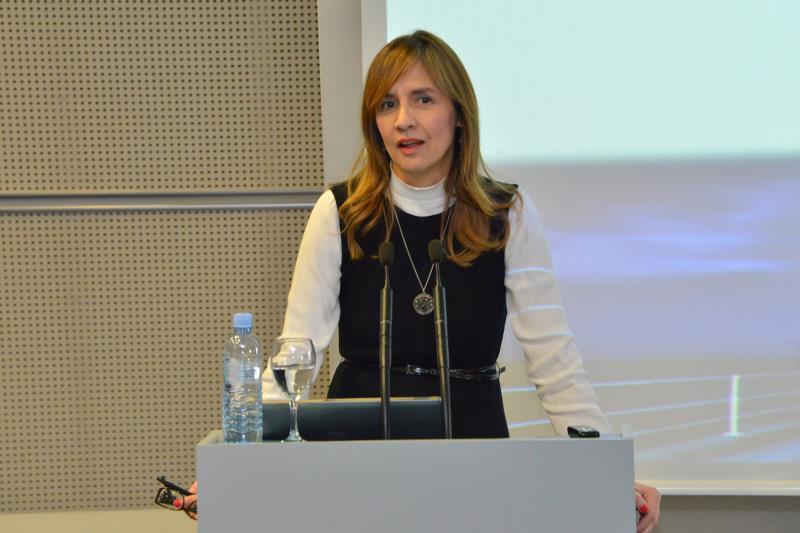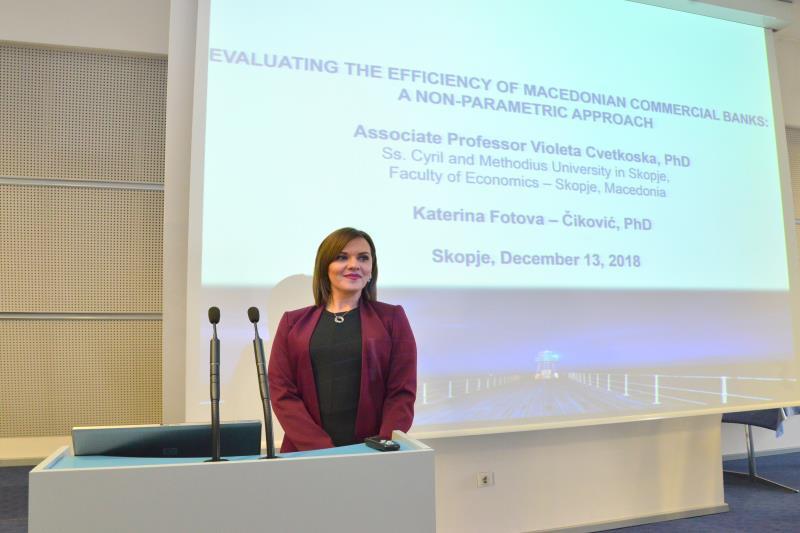 On 13 December 2018, the National Bank of the Republic of Macedonia hosted the 31st Research Club session. The Governor of the NBRM, Anita Angelovska Bezhoska delivered the keynote address followed by presentation of the following research papers: Evaluating the Efficiency of Macedonian Commercial Banks: A Non-Parametric Approach by Katarina Fotova Chikovikj and Violeta Cvetkoska, Associate Professor at the Faculty of Economics, Ss Cyril and Methodius University in Skopje and Disinflationary Spillovers from the Euro Area into the Countries of Southeastern Europe by Gani Ramadani, NBRM and Predrag Pandiloski from The Wharton School of University of Pennsylvania.
On 13 December 2018, the National Bank of the Republic of Macedonia hosted the 31st Research Club session. The Governor of the NBRM, Anita Angelovska Bezhoska delivered the keynote address followed by presentation of the following research papers: Evaluating the Efficiency of Macedonian Commercial Banks: A Non-Parametric Approach by Katarina Fotova Chikovikj and Violeta Cvetkoska, Associate Professor at the Faculty of Economics, Ss Cyril and Methodius University in Skopje and Disinflationary Spillovers from the Euro Area into the Countries of Southeastern Europe by Gani Ramadani, NBRM and Predrag Pandiloski from The Wharton School of University of Pennsylvania.
The first paper by Fotova-Chikovikj and Cvetkoska was focused on assessing the relative efficiency of commercial banks in the Republic of Macedonia, applying DEA window analysis. Based on the profitability approach, the survey incorporated two inputs and two outputs. The analysis sample used by the authors consists of fourteen commercial banks in the country within the period under observation 2007-2017. The results for the average efficiency for the entire period under observation, presented by Violeta Cvetkoska, point to the group of large banks as the most efficient. Presenting the paper on behalf of the two authors, Cvetkoska pointed out that in the ten-year period under observation, the overall Macedonian banking sector was the most efficient in 2007, and the least efficient in 2011. According to their analysis-based perceptions, in the period 2008-2011, efficiency reduced due to the global financial crisis, and then it again increased.

At the summary of the presentation, it was emphasized that the survey results provide information to regulators, policy makers and commercial bank managers, to further improve one of the crucial indicators of success of the financial institutions - their efficiency.
The aim of the research paper by Ramadani and Pandiloski, presented by Gani Ramadani on behalf of the two authors, is to analyze the determinants of inflation movement in Southeast Europe (SEE). As indicated in the presentation, the simultaneous trend of disinflation throughout the region from 2012 to mid-2016 raises the question of whether and to what extent low inflation in the euro area, along with other common factors, affected the disinflation in SEE. Using three-month panel data for ten SEE countries, for the period 2004-2017, the two authors model a hybrid New Keynesian Phillips Curve based on a small and open economy. According to their analysis, the effects of global food and energy prices, as well as the effects of euro area price pressures on the disinfection movements in the SEE countries are crucial.

In general, the survey shows that disinflation spillovers from the euro area are an important factor for countries with a more rigorous exchange rate regime, as well as for those with greater trade with the euro area. Furthermore, the heterogeneity analysis shows that countries with less rigid exchange rate regimes, but relatively high exposure to trade on the euro area market, seem to be sensitive to spillover of inflation in the euro area. Ramadani summarized that cyclical unemployment is not statistically significant in the sample, which is in line with several recent findings for flattening the Phillips curve in many economies in the world.
At the end, encouraged by the presented views and conclusions, the participants discussed issues and aspects of the two presented papers.
The next Research Club session will be held in March 2019.
| |
Галерија - 31. сесија на Клубот на истражувачи |